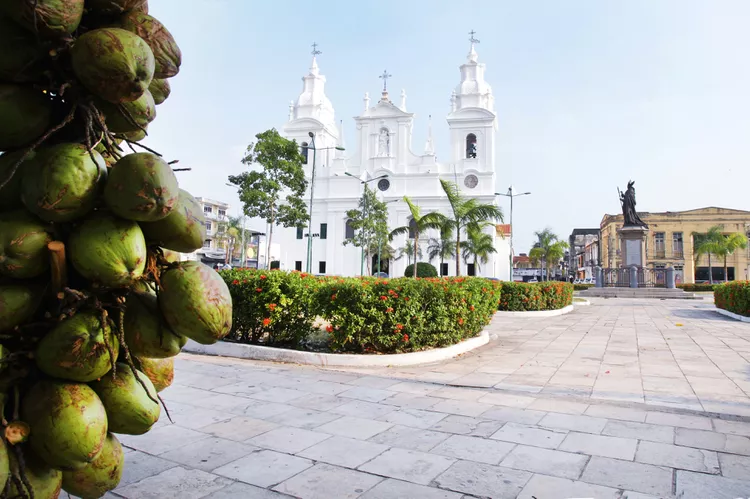Summary
Exploring Belém, Brazil
Belém, located in Pará state, is one of Brazil’s busiest ports and is situated about 60 miles upriver from the Atlantic Ocean. The river, named Pará, is part of the greater Amazon river system, separated from the main part of the Amazon delta by Ilha de Marajó. Belém itself is built on numerous small islands that are interlaced by channels and rivers.
Founded in 1616, Belém was the first European colony on the Amazon but became part of the Brazilian nation in 1775. As the gateway to the Amazon, the port city significantly expanded during the nineteenth-century rubber boom and is now a vibrant metropolis with millions of residents. The modern city boasts skyscrapers and contemporary buildings, while the colonial area retains its charm with tree-filled squares, historic churches, and traditional blue tiles. On the outskirts, the river supports a community known as cablocas, where residents lead lifestyles largely unaffected by urban hustle.
Getting There
Belém serves as a port of call not only for commercial shipping but also for cruise liners and travelers entering the Amazon. Riverboats are the main mode of transportation along the waterways.
Domestic flights are available from Rio de Janeiro, Manaus, and other Brazilian cities. International flights arrive from French Guiana, Suriname, and the US via Miami, all landing at Aeropuerto Internacional Val de Cans, located north of the city. Regular bus services and taxis connect Belém to other Brazilian cities, including Fortaleza, Rio de Janeiro, Belo Horizonte, and São Paulo.
When to Go
Belém experiences a rainy and hot climate with high humidity levels. The equatorial climate results in minimal day-to-day variation. The wettest months typically span from January to May. Regardless of when you visit, be prepared for daily rainfall and elevated temperatures.
To witness a unique cultural experience, consider traveling to Belém for the Círio de Nazaré, celebrated on the second Sunday in October. This festival, dedicated to the Virgin of Nazareth, is Brazil’s largest religious event, featuring hymns, bells, and fireworks.
Shopping Tips
During the height of the nineteenth-century rubber boom, the Ver O Peso market was designed in England and brought to life in Belém. Visitors can find a variety of fresh fruits, plants, and fish transported by dugout canoe. Additionally, the market offers items for macumba ceremonies, medicinal herbs and potions, as well as alligator and crocodile body parts, and even anaconda snakes. Located at the docks, Ver O Peso is one of Brazil’s largest markets.
Highlights
- Belém’s culinary heritage features strong Indian influences, showcasing the richness and deliciousness of local dishes.
- The city is proud of its role as the cultural and economic center of northern Brazil; the Federal University of Pará was established in 1957.
- Belém’s nightlife offers music and dancing, including samba shows, traditional music, carimbó, and popular dance at boates.
- The Goeldi Museum boasts world-famous ethnological and zoological collections from the Amazon, including a zoological-botanical garden with diverse Amazonian wildlife and a remarkable collection of Marajoara ceramics and Indian artifacts.
- The renovated old docks, known as As Docas, now feature a variety of restaurants and shops.
- Near the Mercado Ver o Peso, visitors can enjoy an array of fine dining options along the newly renovated docks.
- From the waterfront, take a stroll to Praça de República to see the historic Teatro da Paz, which has hosted many renowned artists since its inauguration in 1874.
- Cidade Velha is an older district of the city known for its fine mansions built in the popular French style during the rubber boom.
- In Praça do Relógio, named after a replica of London’s Big Ben, stands the Palácio Antônio Lemos, housing the Museo da Cidade. The Palácio Lauro Sodré, dating back to the 1770s, showcases period paintings and historical architecture.
Excursions From Belém
- Icoaracy Village, located about 25 km from Belém, is famed for its local ceramics, including Marajoara and Tapajonic styles.
- The ecological preserve of Ilha de Marajo features pristine beaches along with a diverse range of flora and fauna.
- Mosqueiro Island, situated 80 km from Belém, is connected to the mainland by the Sebastião de Oliveira Bridge, offering beautiful river beaches, restaurants, bars, and hotels.




